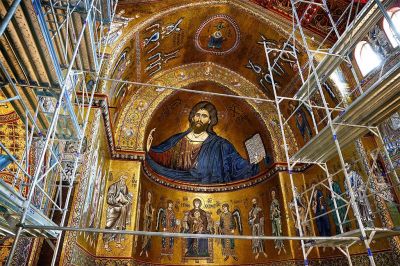The Monreale Cathedral, a UNESCO World Heritage site in Sicily, has unveiled its newly restored mosaics, returning the 12th century masterpieces to their original splendor. The extensive project, funded in part by the European Union, involved meticulous cleaning and repair of the glass tiles, as well as the installation of a state-of-the-art lighting system. The cathedral, commissioned by the Norman King William II, boasts one of the world's largest indoor mosaic collections. Spanning over 7,774 square yards, the shimmering artwork depicts scenes from the Old and New Testaments, crafted using an estimated 2.2 tons of pure gold. "The church is unique in the world," said Father Nicola Gaglio, the local archpriest. "The beauty of its art … strikes you, wounds you, makes you suffer, creates passion and at the same time opens the heart." Among the most breathtaking mosaics is the imposing "Christ Pantocrator" ("ruler of all") in the apse. The cathedral in Monreale, Palermo, is regarded as the most beautiful of the Norman churches in Sicily. The mosaics were made with 2200 kg of pure gold, experts have estimated. Craftsmen from Constantinople were employed to expedite the work. The Byzantine mosaics are among the most magnificent in the world. Years of water damage had taken a toll on the mosaics, prompting a $1.23 million restoration effort. Scaffolding erected during the project is expected to be removed by mid-October. Adding to the revitalized magnificence is a new lighting system designed by Austrian company Zumtobel. "A key focus is to highlight the rich colours of the mosaics, especially the dominant golden tones," explained Zumtobel executive Matteo Cundari. The new illumination, currently in its testing phase, will be officially inaugurated in late November. The Monreale Cathedral stands as a testament to King William II's vision, said to have been inspired by a dream in which the Virgin Mary urged him to build a church on the very spot. Legend has it that a treasure was unearthed from the roots of a carob tree where the king rested, and the golden coins funded the cathedral's construction.
La Cattedrale di Monreale, sito Patrimonio dell’Umanità dell’UNESCO in Sicilia, ha svelato i suoi mosaici appena restaurati, riportando i capolavori del XII secolo al loro splendore originale. Il vasto progetto, finanziato in parte dall'Unione Europea, ha coinvolto una pulizia meticolosa e la riparazione delle tessere di vetro, oltre all’installazione di un sistema di illuminazione all'avanguardia. La cattedrale, commissionata dal re normanno Guglielmo II, vanta una delle più grandi collezioni di mosaici indoor al mondo. Estesi su oltre 6.500 metri quadrati, gli scintillanti mosaici raffigurano scene dell’Antico e del Nuovo Testamento, realizzati utilizzando circa 2,2 tonnellate di oro puro. "La chiesa è unica al mondo," ha detto padre Nicola Gaglio, arciprete locale. "La bellezza della sua arte... ti colpisce, ti ferisce, ti fa soffrire, crea passione e allo stesso tempo apre il cuore." Tra i mosaici più straordinari spicca l’imponente "Cristo Pantocratore" nell’abside. La cattedrale di Monreale, a Palermo, è considerata la più bella tra le chiese normanne della Sicilia. I mosaici furono realizzati con 2200 kg di oro puro, secondo le stime degli esperti. Artigiani di Costantinopoli furono impiegati per accelerare il lavoro. I mosaici bizantini sono tra i più magnifici al mondo. Anni di danni causati dall’acqua avevano deteriorato i mosaici, portando a un progetto di restauro da 1,23 milioni di dollari. I ponteggi eretti durante il restauro dovrebbero essere rimossi entro metà ottobre. Aggiunge ulteriore magnificenza restaurata un nuovo sistema di illuminazione progettato dall’azienda austriaca Zumtobel. "Un punto chiave è mettere in risalto i colori ricchi dei mosaici, specialmente le tonalità dorate dominanti," ha spiegato Matteo Cundari, dirigente della Zumtobel. La nuova illuminazione, attualmente in fase di test, sarà ufficialmente inaugurata a fine novembre. La Cattedrale di Monreale è un testamento alla visione del re Guglielmo II, che si dice sia stata ispirata da un sogno in cui la Vergine Maria lo esortava a costruire una chiesa proprio in quel luogo. La leggenda narra che un tesoro venne dissotterrato dalle radici di un carrubo dove il re si riposava, e che le monete d'oro trovarono impiego nella costruzione della cattedrale.



